
We measured aboveground plant biomass, aboveground net primary productivity (ANPP), detritus accumulation, and nitrogen and phosphorus uptake by aboveground vegetation in six Metrosideros polymorpha stands on the windward slopes of Mauna Loa, Hawai‘i, USA. Our objective was to quantify the effects of elevation (primarily temperature) on ecosystem properties during primary succession, as a key to understanding ecosystem–climate interactions. Four study sites were on 111- to 136-yr-old lava flows at elevations of 290, 700, 1130, and 1660 m. Two additional sites on 3400-yr-old lava were at 700 and 1660 m elevations. All sites were on solid pahoehoe (smooth or ropy-textured) lava substrates with gentle relief, were free of significant human disturbance, received abundant precipitation, and had similar vegetation composition. Total aboveground biomass, soil organic matter mass, and aboveground net primary production (ANPP) were all greater in the old sites than in young sites. Differences between young and old sites in aboveground live biomass, detrital mass, and ANPP all supported the conclusion that ecosystem development proceeded relatively faster at 700 m elevation than at 1660 m. However, aboveground biomass in the old sites (81 Mg/ha at 1660 m elevation and 123 Mg/ha at 700 m) was low in comparison with other wet tropical forests. Accumulations of N and P in live biomass and detritus followed the same trends as were observed for organic matter. Rates of soil carbon accumulation over the first 3400 yr of succession averaged 2.1 g·m−2·yr−1, similar to other reported soil chronosequences. Observed rates of N accumulation ranged from 0.1 to 0.6 g·m−2·yr−1 over the first 136 yr of succession. There were no monotonic elevational trends among young sites with respect to live biomass, detritus mass, or total N or P accumulation. Foliar nitrogen concentrations in the young sites were among the lowest reported from any tropical forests and tended to decline with increasing elevation. The growth and biomass of individual plant species varied in distinctive ways along the elevational gradient. Nevertheless, among young sites there was a direct, linear relationship between total ANPP and mean annual temperature of the site, with a similar pattern in the two old sites. For each 1°C increase in mean annual temperature, total ANPP increased by 54 g·m−2·yr−1. Community-level ANPP also was directly correlated with rates of N and P uptake by the vegetation, regardless of site age or elevation.
Available at: http://works.bepress.com/jim_raich/2/

This article is from Ecology 78 (1997): 707, doi:10.1890/0012-9658%281997%29078%5B0707%3APPAEDA%5D2.0.CO%3B2. Posted with permission.